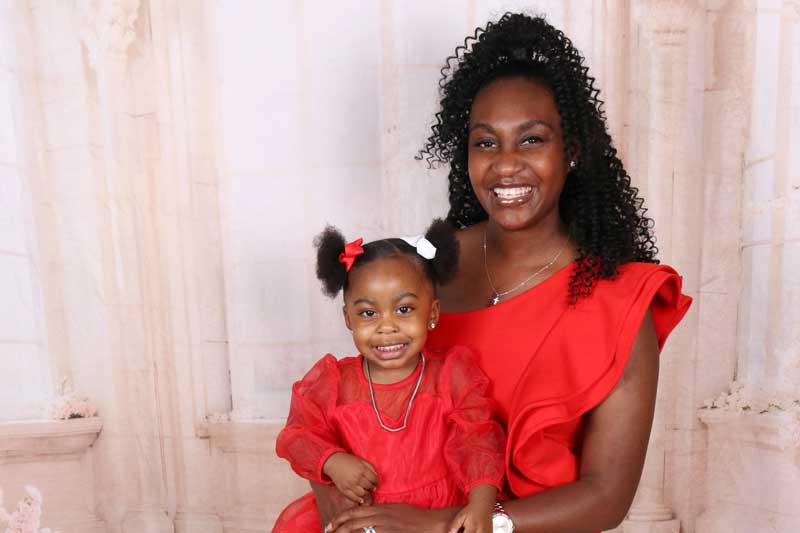Kim's HCM Story

Kimberly Connell, who was diagnosed with hypertrophic cardiomyopathy as a teenager, and her daughter, Kenyah. Kim describes Kenyah as an “answered prayer.” (Photo by Rainee DeMott)
After HCM and a heart transplant, Texas mother feels better than ever
As the fifth of seven children, Kim Connell always had someone to play with and something to do — riding bikes, jumping rope and just generally enjoying being a kid.
At 11, she was diagnosed with a heart murmur, a sign of a problem with a valve in her heart. She had to see more doctors and start taking medicine.
In many cases, people with a murmur are hardly impacted by it. Kim, however, had to deal with her problem growing as she did.
She went from fatigue at 13 to shortness of breath at 14. Those siblings she used to chase? “All I could do was sit in a chair and watch them,” she said.
By 17, she felt depleted. Then came an explanation. A new diagnosis: hypertrophic cardiomyopathy, a condition that causes the walls of the heart to become thicker. HCM was impeding blood flow to and from her heart, causing her to also have congestive heart failure, meaning that her heart wasn’t pumping enough oxygen-rich blood to the rest of her body.
Kim saw the look on her mother’s face and knew immediately this was serious.
Minutes before, they’d been in the car, listening to music. The next, they were receiving life-changing news.
Kim left the hospital that day with what she describes as both literal and figurative “baggage” — the diagnoses, plus a vest she had to wear to protect her; the device would detect an irregular heartbeat and could shock her heart back into a normal rhythm.
Kim began waking up each morning and checking in with her body.
On a good day, she could take a bath, comb her hair and get outside.
On a bad day, she couldn’t get out of bed.
The unpredictability was emotionally challenging.
“I didn’t know how to put my feelings where they belonged,” Kim said.
Further complicating things was trying to finish high school. She’d joined the ROTC in hopes of joining the military; that dream was gone now. Because it was often difficult for her to attend traditional classes, she transferred to an alternative school. She wound up graduating early but missed out on getting to attend a prom.
At 18, Kim was placed on the heart transplant list. Then her heart got stronger. She came off the list.
But she didn’t feel better. She still couldn’t sustain a normal life.
In her early 20s, Kim began taking business classes at a local community college, but heart failure put a stop to it. Frequent hospital stays to drain fluid retained in her body forced her to put school on a back burner. Still, Kim saw these hospitalizations in a positive light: This was what she needed to stay alive and healthy.
At 25, Kim became pregnant. The strain dropped her heart function to 20%; normal range begins at 50%. She went back on the heart transplant list, fearing the impact of the strain of giving birth on her heart. Kim delivered a son at 28 weeks. She named him Isaiah. He died a month later following a staph infection.
A few months later, Kim got the call that she would be receiving a new heart.
“I think most people would have been excited,” Kim said. “I was terrified.”
Ahead of the transplant, Kim had a million thoughts running through her mind. She worried whether she would survive the surgery, and what life would be like after. She also was thankful for the new heart, fearing that she might not have lived much longer without it.
Kim was rolled into the operating room with a sister on one side and her mom on the other. Hours later, her family got the news that the transplant had been a success.
As she recovered, Kim was finally able to breathe well. Walking from the kitchen to the bedroom or climbing a flight of stairs no longer felt like she’d run a marathon.
She credits her faith in God, as well as the support of friends, as instrumental in pulling her through her health struggles.
Today, five years since her transplant, Kim and her new heart spend time working with the WomenHeart Houston support group, a safe space for women with heart disease to talk about their health struggles and triumphs. Kim is the group’s support network coordinator.
Two years ago, she delivered a baby girl, Kenyah. She described that pregnancy as being “like night and day” different from being pregnant with Isaiah while in heart failure.
She describes Kenyah as an “answered prayer.” Her daughter is smart, respectful and active — everything Kim could have imagined.
“Life is worth living because she exists,” Kim said. Her daughter has inspired a new dream of writing children’s books.
Earlier this summer, Kim went in for a checkup. She received another clean bill of health.
“There’s life after heart disease,” she said. “There really, really is, if you want it.”
Kim is a WomenHeart Champion, a program of professionally trained volunteers who dedicate their time and talent to supporting, educating and advocating with and for women living with heart disease like them.
AHA’s HCM education is supported in part through a grant from Bristol Myers Squibb.





